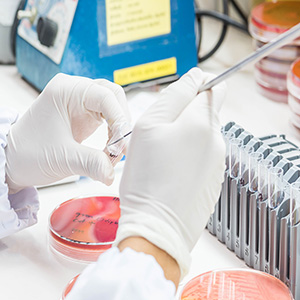Using AI to control energy for indoor agriculture
30 September 2024
Published online 6 September 2023
A new treatment strategy based on stopping the quorum sensing mechanism of communication that is harnessed by armies of bacteria to organise and adapt to stress.

The drive to use quorum sensing comes after a recent study showed that this mechanism is closely linked to the resistance of some bacterial strains to antibiotics. Countering the mechanism has also proven promising for overcoming bacterial resistance and developing other potent treatment to infections.
An Egyptian team set out to assess the approach in a study, recently published in Cell Communication and Signaling.
“Harnessing an alternative tech to face the threat of antibiotic resistance is now essential inevitable to protect against the yearly loss of lives due to this phenomenon,” says Nourhan Naga, a researcher in the botany and microbiology department of Alexandria University’s Faculty of Sciences.
“Quorum-quenching is one alternative strategy currently under study,” Naga told Nature Middle East.
Bacterial messaging
Bacterial communities are very complex, and were found in the 1970s to have a system of communication that allows them to become virulent, only after reaching a ‘certain quorum’.
Incredibly, bacterial communities do communicate and message each other via this main signaling language, says Naga. Therefore, this language has become the target mechanism of action scientists set out to block through a range of ‘quorum-quenchers’, Naga adds.
This communication system, as Naga puts it, means “Each single bacterium can sense neighboring others of its kind, and communicates with them via this chemical quorum sensing mechanism”, to induce alerts and responses regulating gene expression as per what the bacterial volumes in such point in space requires.
The mechanism also controls numerous physiological processes and behavioral responses of gram-positive and gram-negative bacteria through the release of signaling molecules known as auto-inducing peptides (AIP). When these reach a certain threshold level, they trigger the genetic expression processes responsible for a wide array of bacterial cellular functions, mainly the virulence of the bacterium, its antiseptics tolerance, and its ability to form microbial biomolecules called spores. These assist fungi growth, multiplication, motility, toxicity, and formation of biofilms, functions which help the bacteria to adapt to stress while growing in extreme conditions and endow it with antibiotic-resistance.
Genetic switch
Microbiology specialist and immunologist, Helal Fouad Hetta, at Assiut University’s Faculty of Medicine in Egypt noted that the acid, acyl homoserine lactone (AHL), constitutes the signaling molecules responsible for quorum sensing in gram-negative bacteria, whereas the same mechanism uses a group of auto-induced-peptides (AIPs) in gram-positive bacteria.
“When those communication molecules start binding with receptors in the bacteria, they switch on genetic expression and the formation of virulence factors such as biofilms. This in turn triggers immune responses in the body and antibiotic-resistance”, Hetta added.
Over time, scientists gained better insights into the quorum sensing mechanism. In the 1990s, and the early 2000s they uncovered a means of suppressing it via natural and chemical quenchers to inhibit antibiotic resistance.
Vast applications
A plethora of papers exploring the possibilities of harnessing quorum-quenching in the fields of health, agriculture, water treatment, aquiculture, and fisheries were conducted. However, the largest number were in health research. Among other applications, the technique could be used in to control virulent bacterial growth, targeting and suppressing cancer cells, and intercepting the formation of biofilms on medical implants.
Bacterial biofilms are comprised of communities of bacteria that form when free roaming bacteria bind to a surface, such as a medical implant, This can result in infections. Quenchers can prevent the formation of these films by knocking out quorum sensing used in the communication amongst the bacterial communities.
Naga pointed out that Furanone c30 — found in natural sources and fruits, and the cause of the aroma of pineapples and tomatoes — is the most promising quorum quenching agent to date. It can also be purchased as an isolate chemical compound extracted from a natural source.
Quorum-quencher treatments
Many natural and chemical quorum-quenchers were discovered and tested in laboratory trials, even clinically in the case of some natural compounds. However, to date, there is no single quorum-quencher-based drug approved by the US FDA.
Naga points out that the biggest challenge facing the development of quorum-quencher treatments working against antibiotic-resistant bacteria, is conducting large scale trials to detect the potential side effects, especially for humans.
Khaled Abu Shanab, professor of microbiology and immunology at Ain Shams University’s Faculty of Pharmacy attributes the delay in approving the use of drugs, alternative to antibiotics and reliant on quorum-quenching to the fact that their efficacy differs from one bacterium to another, and from gram-positive to gram-negative bacteria. In other words, each quorum-quencher agent works differently.
Abu shanab also told Nature Middle East: “Scientists are struggling to prevent the toxicity of some of these quenchers, and preclude off-target adverse interactions”.
Abu Shanab notes that quorum-quenchers have proven effective in knocking out quorum sensing in vitro, and that further research was conducted on model animals. However, most trials did not succeed in preventing infections in the human body due to serious adverse reactions, such as cellular toxicity and interactions with human tissue.
doi:10.1038/nmiddleeast.2023.155
Stay connected: